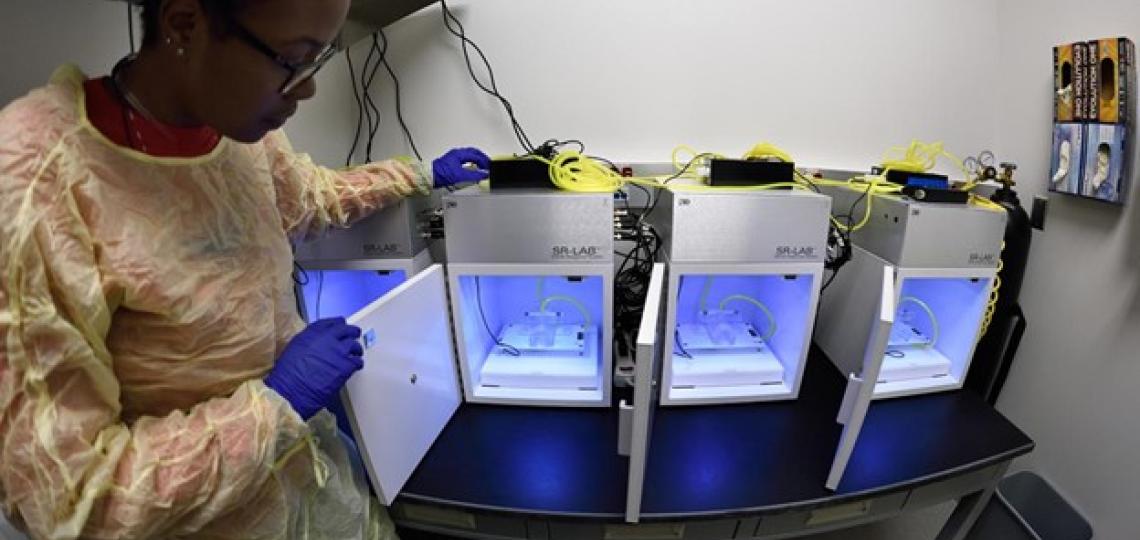
About the Core
The goals of the preclinical phenotyping component of PCO Core include:
- Expert consultation for experimental design and data analysis
- Training for specific assays provided by expert staff
- High-quality, efficient, and cost-effective service
- Educational workshops on various topics and data analysis, technical issues, trouble-shooting, topics in behavioral neuroscience/genetics
- Innovation and development of novel assays as preclinical outcome measures.
We have two rodent neurobehavioral core facilities located on BCM Main Campus and in the Jan and Dan Duncan Neurological Research Institute encompassing ~5,000 sq.ft. of space dedicated to behavioral studies of rodent models of disease. Our cores for mouse model studies have 32 rooms available for testing, containing state-of-the-art equipment to evaluate behavioral domains such as anxiety-like behavior, mood, multiple aspects of motor function and coordination, various learning/memory paradigms, social behavior, vocalization, pain, perseverative behavior, circadian activity as well as whole body autonomic measurements such as unrestrained plethysmography.
Available Services
Activity and Anxiety Related
Mouse Cores | ||
| Test/Evaluation | Transgenic Mouse Facility | Neurological Research Institute |
| ClockLab wheel-running system |
| ● |
| Open-field activity (automated detection) | ● | ● |
| Light-dark exploration (automated detection) | ● | ● |
| Light-dark exploration (manual scoring) | ● | ● |
| Elevated plus maze (video-assisted, automated) | ● | ● |
| Elevated plus maze (manual scoring) | ● | ● |
| Elevated circle maze (video-assisted, automated) | ● | ● |
| Elevated circle maze (manual scoring) | ● | ● |
Repetitive and Perseverative-Related
Mouse Cores | ||
| Transgenic Mouse Facility | Neurological Research Institute | |
| Marble burying assay | ● | ● |
| Grooming assay | ● | ● |
| Holeboard (automated) | ● | ● |
| Water T-maze | ● | ● |
| Fear extinction | ● | ● |
Motor Coordination and Function
Mouse Cores | ||
| Transgenic Mouse Facility | Neurological Research Institute | |
| Accelerating rotating rod | ● | ● |
| Wirehang | ● | ● |
| Dowel walking | ● | ● |
| Vertical pole test | ● | ● |
| Grid footslip test | ● | ● |
| Parallel rod footslip test | ● | ● |
| Grip strength meter | ● | ● |
| Fine forepaw motor skill tasks | ● | ● |
| DigiGait gait analysis |
| ● |
| Catwalk gait analysis | ● | ● |
| Treadmill |
| ● |
Sensory and Sensorimotor
Mouse Cores | ||
| Transgenic Mouse Facility | Neurological Research Institute | |
| Acoustic startle test paradigms | ● | ● |
| Tactile startle test paradigms |
| ● |
| Prepulse inhibition test paradigms | ● | ● |
| Hot plate | ● | ● |
| Tail flick | ● | ● |
| Von Frey filaments (manual application) | ● | ● |
| Formalin Test | ● | ● |
| Social and non-social olfaction | ● | ● |
Learning and Memory
Mouse Cores | ||
| Transgenic Mouse Facility | Neurological Research Institute | |
| Conditioned Fear | ● | ● |
| Morris water maze | ● | ● |
| Passive/active avoidance | ● | ● |
| T-maze spontaneous alternation | ● | ● |
| Novel object location | ● | ● |
| Conditioned place preference | ● | ● |
| Y-maze spontaneous alternation | ● | ● |
| Visual discrimination test | ● | ● |
| Touch Screen Operant System (9 different tasks) | ● | ● |
| Barnes Maze |
| ● |
| Water T-maze | ● | ● |
Social Behavior
Mouse Cores | ||
| Transgenic Mouse Facility | Neurological Research Institute | |
| Tube test for dominance | ● | ● |
| Partition test sociability | ● | ● |
| 3-chamber test for social preference and novelty | ● | ● |
| Resident intruder test for aggression | ● | ● |
| Direct social interaction test | ● | ● |
| Ultrasonic vocalization recording (Noldus, Avisoft and Audacity available) | ● | ● |
Mood/Depression-Like
Mouse Cores | ||
| Transgenic Mouse Facility | Neurological Research Institute | |
| Tail suspension | ● | ● |
| Porsolt forced swim test | ● | ● |
Reward/Addiction-Like
Mouse Cores | ||
| Transgenic Mouse Facility | Neurological Research Institute | |
| Conditioned place preference | ● | ● |
| Sucrose preference test (Two-bottle choice) | ● | ● |
Induced Behavioral Seizures
Mouse Cores | ||
| Transgenic Mouse Facility | Neurological Research Institute | |
| Audiogenic seizure induction | ● | ● |
| Kainate induced seizures | ● | ● |
Tremor Assessment
Mouse Cores | ||
| Transgenic Mouse Facility | Neurological Research Institute | |
| Tremor meter |
| ● |
Recent Publications from the Core
- Cheng YT, Woo J, Luna-Figueroa E, Maleki E, Harmanci AS, Deneen B. Social deprivation induces astrocytic TRPA1-GABA suppression of hippocampal circuits. Neuron. 2023 Apr 19;111(8):1301-1315.e5. doi: 10.1016/j.neuron.2023.01.015. Epub 2023 Feb 13. PMID: 36787749; PMCID: PMC10121837.
- Zhou J, Hamdan H, Yalamanchili HK, Pang K, Pohodich AE, Lopez J, Shao Y, Oses-Prieto JA, Li L, Kim W, Durham MA, Bajikar SS, Palmer DJ, Ng P, Thompson ML, Bebin EM, Müller AJ, Kuechler A, Kampmeier A, Haack TB, Burlingame AL, Liu Z, Rasband MN, Zoghbi HY. Disruption of MeCP2-TCF20 complex underlies distinct neurodevelopmental disorders. Proc Natl Acad Sci U S A. 2022 Jan 25;119(4):e2119078119. doi: 10.1073/pnas.2119078119. PMID: 35074918; PMCID: PMC8794850.
- Ru Q, Lu Y, Saifullah AB, Blanco FA, Yao C, Cata JP, Li DP, Tolias KF, Li L. TIAM1-mediated synaptic plasticity underlies comorbid depression-like and ketamine antidepressant-like actions in chronic pain. J Clin Invest. 2022 Dec 15;132(24):e158545. doi: 10.1172/JCI158545. PMID: 36519542; PMCID: PMC9753999.
- Kim J, de Haro M, Al-Ramahi I, Garaicoechea LL, Jeong HH, Sonn JY, Tadros B, Liu Z, Botas J, Zoghbi HY. Evolutionarily conserved regulators of tau identify targets for new therapies. Neuron. 2023 Mar 15;111(6):824-838.e7. doi: 10.1016/j.neuron.2022.12.012. Epub 2023 Jan 6. PMID: 36610398.
- Bajikar SS, Anderson AG, Zhou J, Durham MA, Trostle AJ, Wan YW, Liu Z, Zoghbi HY. MeCP2 regulates Gdf11, a dosage-sensitive gene critical for neurological function. Elife. 2023 Feb 27;12:e83806. doi: 10.7554/eLife.83806. PMID: 36848184; PMCID: PMC9977283.
- Achilly NP, Wang W, Zoghbi HY. Presymptomatic training mitigates functional deficits in a mouse model of Rett syndrome. Nature. 2021 Apr;592(7855):596-600. doi: 10.1038/s41586-021-03369-7. Epub 2021 Mar 24. PMID: 33762729; PMCID: PMC8093094.
- Shao Y, Sztainberg Y, Wang Q, Bajikar SS, Trostle AJ, Wan YW, Jafar-Nejad P, Rigo F, Liu Z, Tang J, Zoghbi HY. Antisense oligonucleotide therapy in a humanized mouse model of MECP2 duplication syndrome. Sci Transl Med. 2021 Mar 3;13(583):eaaz7785. doi: 10.1126/scitranslmed.aaz7785. PMID: 33658357; PMCID: PMC8976688.
- Coffin SL, Durham MA, Nitschke L, Xhako E, Brown AM, Revelli JP, Villavicencio Gonzalez E, Lin T, Handler HP, Dai Y, Trostle AJ, Wan YW, Liu Z, Sillitoe RV, Orr HT, Zoghbi HY. Disruption of the ATXN1-CIC complex reveals the role of additional nuclear ATXN1 interactors in spinocerebellar ataxia type 1. Neuron. 2023 Feb 15;111(4):481-492.e8. doi: 10.1016/j.neuron.2022.11.016. Epub 2022 Dec 27. Erratum in: Neuron. 2023 Mar 15;111(6):915. PMID: 36577402; PMCID: PMC9957872.
- Lee D, Chen W, Kaku HN, Zhuo X, Chao ES, Soriano A, Kuncheria A, Flores S, Kim JH, Rivera A, Rigo F, Jafar-Nejad P, Beaudet AL, Caudill MS, Xue M. Antisense oligonucleotide therapy rescues disturbed brain rhythms and sleep in juvenile and adult mouse models of Angelman syndrome. Elife. 2023 Jan 3;12:e81892. doi: 10.7554/eLife.81892. PMID: 36594817; PMCID: PMC9904759.
- van der Heijden ME, Gill JS, Sillitoe RV. Abnormal Cerebellar Development in Autism Spectrum Disorders. Dev Neurosci. 2021;43(3-4):181-190. doi: 10.1159/000515189. Epub 2021 Apr 6. PMID: 33823515; PMCID: PMC8440334.
- Miterko LN, Lin T, Zhou J, van der Heijden ME, Beckinghausen J, White JJ, Sillitoe RV. Neuromodulation of the cerebellum rescues movement in a mouse model of ataxia. Nat Commun. 2021 Feb 26;12(1):1295. doi: 10.1038/s41467-021-21417-8. PMID: 33637754; PMCID: PMC7910465.
- Orengo JP, Nitschke L, van der Heijden ME, Ciaburri NA, Orr HT, Zoghbi HY. Reduction of mutant ATXN1 rescues premature death in a conditional SCA1 mouse model. JCI Insight. 2022 Apr 22;7(8):e154442. doi: 10.1172/jci.insight.154442. PMID: 35290244; PMCID: PMC9089789.
- Le JT, Ballester-Rosado CJ, Frost JD Jr, Swann JW. Neurobehavioral deficits and a progressive ictogenesis in the tetrodotoxin model of epileptic spasms. Epilepsia. 2022 Dec;63(12):3078-3089. doi: 10.1111/epi.17428. Epub 2022 Oct 12. PMID: 36179064; PMCID: PMC9742150.
- Achilly NP, He LJ, Kim OA, Ohmae S, Wojaczynski GJ, Lin T, Sillitoe RV, Medina JF, Zoghbi HY. Deleting Mecp2 from the cerebellum rather than its neuronal subtypes causes a delay in motor learning in mice. Elife. 2021 Jan 26;10:e64833. doi: 10.7554/eLife.64833. PMID: 33494858; PMCID: PMC7837679.
Meet Our Team

Director
713-798-6124
veerarag@bcm.edu
For consultation and training to use the behavior core please contact Dr. Surabi Veeraragavan.
Acknowledgment
We ask that users acknowledge the use of this core as follows:
"The project described was supported in part by the Preclinical and Clinical Outcomes Core at Baylor College of Medicine, which is supported by IDDRC Grant Number P50HD103555 from the Eunice Kennedy Shriver National Institute of Child Health & Human Development. The content is solely the responsibility of the authors and does not necessarily represent the official views of the Eunice Kennedy Shriver National Institute of Child Health & Human Development or the National Institutes of Health.”








